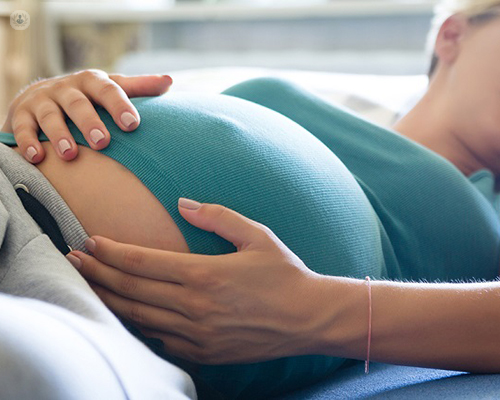Rectus diastasis: a common post-pregnancy problem
Written in association with:Diastasis recti or divarication of rectus, is a very common condition usually affecting women. It is typically seen following pregnancy, caused by stretching of the abdominal wall by the enlarged uterus, sometimes referred to as postpartum stomach pooch. However, it can also affect men, typically those involved in bodybuilding and lifting heavy weights.
Diastasis recti literally refers to a separation between the left and right side of the rectus abdominis muscles, the so called ‘6 pack’, which provide coverage for the top, middle and lower part of the belly area.

Is rectus diastasis a type of hernia?
A diastasis of the abdominal wall is not a hernia. Clinically, a diastasis may look like a hernia in the sense that when the abdomen is flexed, there is a noticeable and cosmetically unpleasing bulge, usually located in the upper abdomen, in the midline above your belly button. However, there is a big difference. A hernia is a hole in the fascia (the connective tissue below the skin that stabilises the muscles), while diastasis is just stretched out midline fascia, and not a real hernia. Thus a diastasis has no real incidence of developing an emergent incarceration or strangulation. A diastasis, with stretched out midline fascia, results in your two rectus (6 pack) muscles being far apart.
How is rectus diastasis recognised?
A diastasis recti looks like a ridge, which runs down the middle of the belly area. It stretches from the bottom of the breastbone towards the navel, (and sometimes even lower towards the pubis) and increases with muscle straining.
In women who have had multiple pregnancies, since the muscles have been stretched often, extra skin and soft tissue in the front from the abdominal wall could be the only signs and symptoms of this condition.
A doctor can diagnose this condition by performing a physical exam. A simple ‘sit-up’ or stomach crunch exercise will demonstrate a bulging ridge running from breastbone to navel. The degree of diastasis or divarication can be defined objectively on an ultrasound or CT scan.
Abdominal wall function weakness is a common symptom, and has often been reported as improved after diastasis repair.
What causes rectus diastasis?
The term diastasis means separation. In pregnant women, increased tension around the abdominal wall can lead to diastasis recti. Multiple births or repeated pregnancies increase the risk of divarication of rectus.
Its incidence in childbearing women is 66%, commonly occurring in the third trimester, and can persist in 30–60% of women during the postpartum period as well.
In men, increased abdominal pressure from weight lifting can have the same effect. Other etiological factors include chronic or intermittent abdominal distension, advancing age, or familial weakness of the abdominal musculofascial tissues.
How is rectus diastasis repair performed?
Repair options for diastasis recti include:
- No surgery. Trial of time and/or abdominal exercises and/or physiotherapy.
- Open primary repair (often done by a plastic surgeon at the same time as an abdominoplasty to removed excess skin)
- Open mesh repair (this is rarely done or required for primary diastasis).
- Laparoscopic diastasis suture repair with or without mesh reinforcement. The main objective of this option is to use a suture to realign your rectus muscles to the midline.
- Occasionally, the surgeon may combine laparoscopic diastasis repair with umbilical hernia repair should they co-exist.
The benefits of the laparoscopic approach are, as for any laparoscopic versus open technique, most notably improved recovery time, reduced pain and wound infection, and improved cosmesis.
Despite being symptomatic, a diastasis repair alone is still considered elective and cosmetic, and is therefore not reimbursed by most insurance companies.
However, on occasion a case may be made stating that it affects day-to-day life (difficulty lifting things, including children) and that exercise attempts have not helped.
Results of surgery
Repair for cosmesis and restoring function of the recti muscles is nearly always successful. The laparoscopic approach offered by Mr Ahmed has the immense benefit of minimising scars. Mr Ahmed offers a minimally invasive (laparoscopic) diastasis repair.
There is no skin excision, which is a big difference from a traditional plastic surgery abdominoplasty, which is a much bigger operation leaving a large scar.
Risks of surgery
Recurrent diastasis recti is possible, as are seromas. Cosmetic results can not always be guaranteed.
Postoperative care
We advise our patients to wear an abdominal compression binder (corset) for a period of 4-6 weeks following surgery, for support.
The patient will stay in the hospital for at least one night. Because your abdominal muscles are stitched back together so tightly (think of a corset that laces in the front), your back will hunch over at first. Pain relief with paracetamol and ibuprofen is effective but on occasion stronger medication may be needed.
Patients will need time off work of around 1-2 weeks. During that time, the patient can’t lift their children (or anything else) for eight weeks.
All being said – the surgery is worth it. If your separation is uncomfortable and unsightly, and not responding to core strength exercises, affecting your posture; then having laparoscopic surgical repair is worth it.
Most patients notice after this surgery: clearly improved cosmesis, better posture, improved abdominal wall function, reduced core pain, and improved back pain.
Other tips before diastasis surgery
Patients with obesity (BMI greater than 35) should try to lose weight to keep a body mass index less than 35 if possible. If you have obesity, it is not advised to have a diastasis repair as the recurrence rates are quite high.
Patients also should only consider diastasis repair if they don’t want to have any more children. Further pregnancies can reverse the effects of the corrective surgery.
If you are interested in having diastasis recti repair surgery, you can make an appointment with Mr Ahmed by visiting his profile here.


